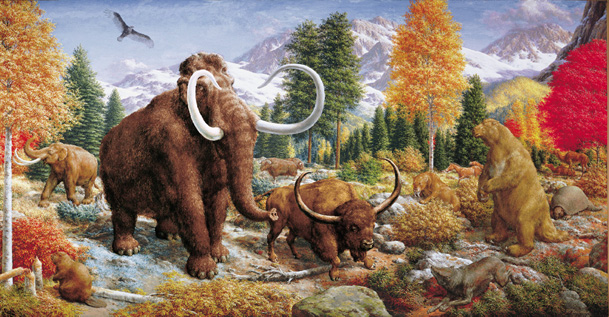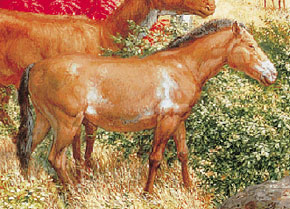Plio-Pleistocene
Plio-Pleistocene (5.3 MYA – 11,700 years BCE)

An extract from Rudolph F. Zallinger’s mural “The Age of Mammals,” showing reconstructions of Pleistocene mammals. From left to right these are the mastodon Mammut americanum; Castoroides, a giant beaver the size of a modern black bear; the giant bird Teratornis; the wooly mammoth, Mammuthus primigenius; the woodland musk ox Bootherium; the extinct bison Bison crassicornis; Smilodon, a saber-toothed cat; a dire wolf, Canisdirus; horses of the modern genus Equus; Megatherium, a giant ground sloth; an armored glyptodont, Glyptodon; and the extinct American camel Camelops. © Yale University
The Pliocene and Pleistocene epochs are commonly combined and referred to as the Plio-Pleistocene because of their short duration in comparison to previous epochs, and also because the events that took place during these epochs are very closely associated. The Pliocene spans the interval 5.3 - 2.6 MYA and the Pleistocene 2.6-0.01 MYA.
Two very important events of the Pliocene are the formation of Arctic ice sheets, heralding the beginning of the ice age, and the emergence of a land bridge between South America and North America, ending the 60-million-year isolation of South America. This allowed some unique South American mammals- such as armadillos, glyptodonts, and giant ground sloths- to migrate into North America, and many more North American species; including horses, tapirs, saber toothed cats, mammoths, peccaries, and deer; to enter South America. There were widespread extinctions of endemic South American mammals.
The Pliocene also saw the emergence of the first hominins (humans and their ancestors). These early ancestors of our own species, such as Australopithecus, first appeared in Africa, where they shared their environment with familiar species of modern mammal, including perissodactyls like zebras, white rhinos, and black rhinos. The Pleistocene covers the past 2.6 million years and is characterized by repeated glacial periods, when vast ice sheets covered much of the Northern Continents, and interglacials, when the ice receded (but did not completely melt). It is within this time period that our species (Homo sapiens) first appeared, migrated out of Africa, and developed cultural adaptations to life in a frigid climate.
The mammal fauna of the ice ages is dominated by large species, such as mammoths and mastodons, giant deer such as Megaloceras, large predators (cave bears, lions, and saber-tooth cats), as well as woolly rhinos (Coelodonta), and anatomically modern horses (Equus). Much of this mammalian “Megafauna” is now extinct, possibly as a result of hunting by humans although this remains a subject of intense scientific debate.
Despite its short duration, the fossil record of the Pleistocene is very extensive on every continent. Because of glaciation trapping water in ice sheets, the sea level was lower and shore lines in many areas were much farther out than today; many Pleistocene fossils of land mammals have been recovered from the North Sea, demonstrating that is was once exposed. One of the best known localities for Pleistocene mammals is the LaBrea tar pits in Los Angeles. During the Pleistocene, large animals such as mammoths and horses would get mired in the sticky tar and attract predators like dire wolves and saber toothed cats, which would become trapped in turn, buried, and preserved.

